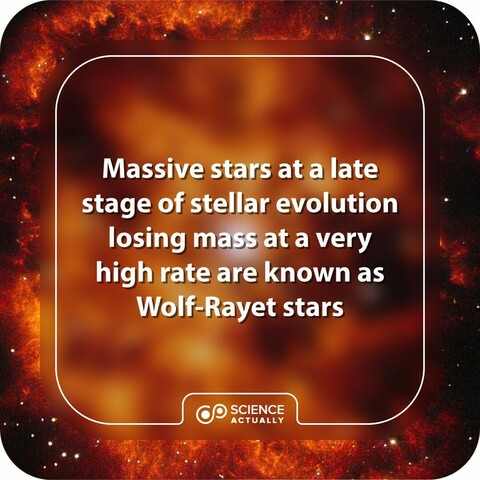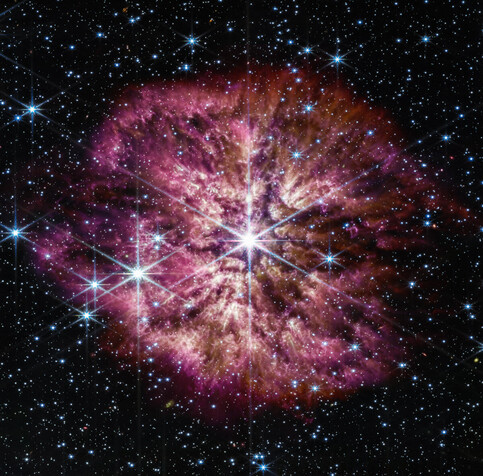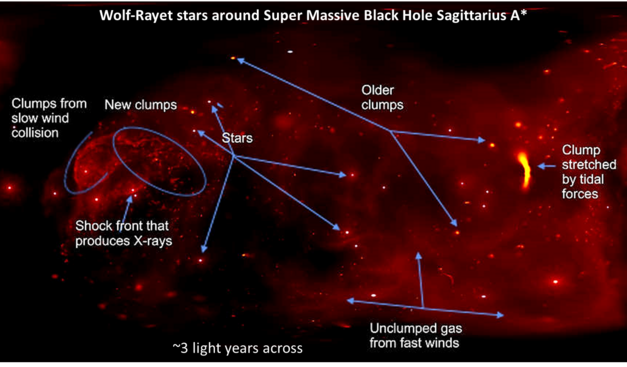Kuuke's Sterrenbeelden · @kuuke
49 followers · 389 posts · Server mastodon.nlNieuw type ster geeft aanwijzingen voor mysterieuze oorsprong van magnetars
Magnetars zijn de sterkste magneten in het heelal. Deze superdichte dode sterren met ultrasterke magnetische velden zijn overal in ons sterrenstelsel te vinden, maar astronomen weten niet precies hoe ze ontstaan.
https://www.kuuke.nl/nieuw-type-ster-geeft-aanwijzingen-voor-mysterieuze-oorsprong-van-magnetars/
#wolfrayet #monoceros #magnetar #heliumster #hd45166
Mr.Trunk · @mrtrunk
1 followers · 202 posts · Server dromedary.seedoubleyou.meGaze in Wonder at These Stunning Views of the Cosmos https://gizmodo.com/stunning-views-cosmos-royal-observatory-contest-1850595027 #southernconstellations #supernovaremnants #coronaaustralis #constellations #spaceplasmas #spiralgalaxy #solarsystem #wilddrawing #environment #themilkyway #burgerking #ngcobjects #supernova #wolfrayet #milkyway #pandora #thestar #nebula #ara
#southernconstellations #supernovaremnants #coronaaustralis #constellations #spaceplasmas #spiralgalaxy #solarsystem #wilddrawing #environment #themilkyway #burgerking #ngcobjects #supernova #wolfrayet #milkyway #pandora #thestar #nebula #ara
Dr. Juande Santander-Vela · @juandesant
578 followers · 6459 posts · Server astrodon.social@jeffzugale no, but I have colleagues who do… I’ll try to get them to see your work!
#wolfrayet #WRS #wolfrayetstar #wolfrayetstars
ScienceActually · @scienceactually
32 followers · 102 posts · Server sfba.socialMassive stars which are at an advanced stage of stellar evolution and losing mass at a very high rate are known as Wolf-Rayet stars.
#science #sciencefacts #star #stars #WolfRayet #stellarevolution #evolution
#science #sciencefacts #star #stars #wolfrayet #stellarevolution #evolution
CosmicRami · @CosmicRami
1087 followers · 485 posts · Server aus.socialHave been observing with Parkes on the graveyard shift most of this week, and to keep myself awake I spent a bit of time processing some data from #JWST target: Wolf-Rayet 124.
These stars are hot, massive stars with stellar winds that are literally shredding the star's outer layers, creating this massive, beautiful and bright nebula. They're also some of the hottest stars known and are precursors to violent supernova events This one is about 15,000 light-years away.
The two different instruments on the JWST sees different features, and so we see different structures of this ferocious star. To generate these, I used four base tones in each and stacked as best I could.
On the left is the NIRCAM instrument, with filter F444W. On the right is the MIRI instrument with filter F1800W.
📷 JWST/STScI/KM Pontoppidan
#jwst #wolfrayet #astronomy #stars #Astrodon
Peter Motte · @PeterMotte
44 followers · 554 posts · Server social.linux.pizza#nasa #wolfrayet 124
Wolf-Rayet star: among the most luminous, most massive, and most briefly detectable stars known, observed by JWST in June 2022.
Massive stars race through their lifecycles, some go through a WR phase before supernova.
WR stars are in the process of casting off outer layers, resulting in halos of gas & dust. WR 124 (fig.) is 30x the mass of the Sun and has shed 10 Suns’ worth of material – so far. Ejected gas moves away and cools, forms cosmic dust and glows in IR
scinexx - das wissensmagazin · @scinexx
27 followers · 184 posts · Server nrw.socialBild der Woche: Ein sterbender Sternenriese. James-Webb-Teleskop zeigt den Wolf-Rayet-Stern WR 124. #JWST #Astronomie #WolfRayet #Stern #WebbTeleskop https://www.scinexx.de/fotos/ein-sterbender-sternenriese/
#JWST #astronomie #wolfrayet #Stern #WebbTeleskop
AkaSci · @AkaSci
1000 followers · 911 posts · Server fosstodon.orgThis 360° visualization based on data from Chandra and other telescopes shows ~25 Wolf-Rayet stars around the Milky Way's supermassive black hole Sgr A*.
"The movie shows 2 simulations, each of which start around 350 years in the past and span 500 years. The 1st one shows Sgr A* in a calm state, the 2nd has a more violent Sgr A* that is expelling material, turning off the accretion of clumped material (yellow blobs) prominent in the 1st portion."
AkaSci · @AkaSci
1000 followers · 910 posts · Server fosstodon.orgDozens of massive Wolf-Rayet stars are known to orbit within 1.5 ly of the central super massive black hole Sgr A* in our own galaxy.
The fierce stellar winds of the WR stars collide with each other creating shock waves and clumps of gas and dust, which heat up to millions of degrees and emit X-rays.
Some of these clumps spiral into the black hole. Some of the material gets ejected into interstellar space.
https://chandra.harvard.edu/photo/2018/gcenter360/
#JWST #WR124 #WolfRayet #SgrA*
4/n
· @Cassana
624 followers · 1441 posts · Server universeodon.comI've said it before, but the James #Webb #Telescope is doing some truly amazing stuff! #Astronomy #cosmology #science #discovery #news
"#WolfRayet #stars are a rare prelude to the famous final act of massive stars: the #supernova. In one of its first observations, #NASA’s James Webb #Space Telescope captured the Wolf-Rayet star WR 124 in unprecedented detail. A distinctive halo of gas and dust frames the star and glows in the infrared light detected by Webb, displaying knotty structure and a history of episodic ejections. Despite being the scene of an impending stellar “death,” astronomers also look to Wolf-Rayet stars for insight into new beginnings. Cosmic dust is forming in the turbulent nebulas surrounding these types of stars, which is composed of the heavy-element building blocks of the modern #universe, including life on #Earth."
https://webbtelescope.org/contents/news-releases/2023/news-2023-111
#webb #telescope #astronomy #cosmology #Science #discovery #news #wolfrayet #stars #supernova #nasa #Space #universe #earth
Starry Time Podcast · @starrytimepod
268 followers · 543 posts · Server universeodon.comThis is a Wolf-Rayet star recently imaged by the #JWST! This is WR 124 & it is located in the #constellation #sagittarius.
This dazzling image has got me rethinking Jordan's choice for Gold Star of the month from Ep 12...
#astronomy #astrophotography #astrodon #space #WolfRayet #podcast
#jwst #constellation #sagittarius #astronomy #astrophotography #Astrodon #Space #wolfrayet #Podcast
Daniel Fischer · @cosmos4u
1239 followers · 1812 posts · Server scicomm.xyzThe rare sight of a #WolfRayet star – among the most luminous, most massive, and most briefly-detectable stars known – was one of the first observations made by NASA’s James #Webb Space Telescope in June 2022: https://webbtelescope.org/contents/news-releases/2023/news-2023-111 and https://www.esa.int/Science_Exploration/Space_Science/Webb/Webb_captures_rarely_seen_prelude_to_a_supernova - Webb shows the star, WR 124, in unprecedented detail with its powerful infrared instruments NIRCam and MIRI from 900 nm to 18 µm; t The star is 15,000 light-years away in the constellation Sagittarius.
Daniel Fischer · @cosmos4u
1239 followers · 1812 posts · Server scicomm.xyzThe rare sight of a #WolfRayet star – among the most luminous, most massive, and most briefly-detectable stars known – was one of the first observations made by NASA’s James #Webb Space Telescope in June 2022: https://webbtelescope.org/contents/news-releases/2023/news-2023-111 and https://www.esa.int/Science_Exploration/Space_Science/Webb/Webb_captures_rarely_seen_prelude_to_a_supernova - Webb shows the star, WR 124, in unprecedented detail with its powerful infrared instruments NIRCam and MIRI from 900 nm to 18 µm; t The star is 15,000 light-years away in the constellation Sagittarius.
Archmonad of Saturn · @voidshaper
54 followers · 158 posts · Server universeodon.comWolf-Rayet stars are a category of different types of stars which are all, frankly, horrifying.
Surface temperatures up to 210k K, which is figuratively hot enough to burn our sun (10k K).
Stellar winds so strong they're constantly ripping the star apart, creating nebulas with ejecta chunks as big as the distance from Earth to Saturn.
There's one that's 4.7 million times as luminous as the sun.
Image: WR124 by @spacegeck
#space #wolfrayet #astrodon









